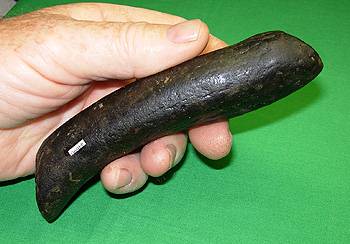[ii] McAvoy, Joseph M. and Lynn D. McAvoy
1997 Archaeological Investigations of Site 44SX202,m Cactus Hill, Sussex County, Virginia
Antler billet or baton
The antler flaker was described by DeJarnette, Kurjack, and Cambron (1962) at the Stanfield-Worley Bluff Shelter site as a section of antler, usually a tine or “point,” with a smaller end presumably shaped for, or worn by the flaking process.
Several examples of antler flaking tools were reported from burial 6 at the Stanfield-Worley site. This was a Morrow Mountain burial dating to about 6,500 years B.P. Joffre Coe recovered[ii] a graver was recovered that, when tested for blood residual, tested positive for deer. Gravers might have been used to score antler before snapping the antler off to use for flakers. In addition, edge worked flakes were recovered below Clovis material at the site that dated to 18,000 calendar years B.P. One broken fluted point was resharpened by beveling by pressure flaking the alternate edges of the point. All of this evidence suggests that antler flakers were in use as early as, at least the Paleoindian period.

Antler billets are short sections of antler that show evidence of extensive handling with gloss along the handle and roughness and sometimes breakage at the working end. Very few archaeologists actually call these short sections of antler billets. They are more often not identified at all or are regarded as handles even though they have no provision for hafting.
One example was also recovered from the 10 to 21 foot level at the Modoc site (Fowler & Winters 1956). Zones II and III of that site dated between 8,219 and 5325One example was also recovered from the 10 to 21 foot level at the Modoc site (Fowler & Winters 1956). Zones II and III of that site dated between 8,219 and 5325 years B.P. Lewis and Kneberg (1946) reported finding examples of Antler flakers of this type in the Hamilton component of the Hiwassee site in Tennessee. The Hamilton component burial in which they were discovered dated to Woodland period. Ward recovered one antler billet from the Saratown level of the William Klutz site in North Carolina that dated between A.D. 1500 and 1700. years B.P. Lewis and Kneberg (1946) reported finding examples of Antler flakers of this type in the Hamilton component of the Hiwassee site in Tennessee. The Hamilton component burial in which they were discovered dated to Woodland period. Ward recovered one antler billet from the Saratown level of the William Klutz site in North Carolina that dated between A.D. 1500 and 1700.
[ii] McAvoy, Joseph M. and Lynn D. McAvoy
1997 Archaeological Investigations of Site 44SX202,m Cactus Hill, Sussex County, Virginia